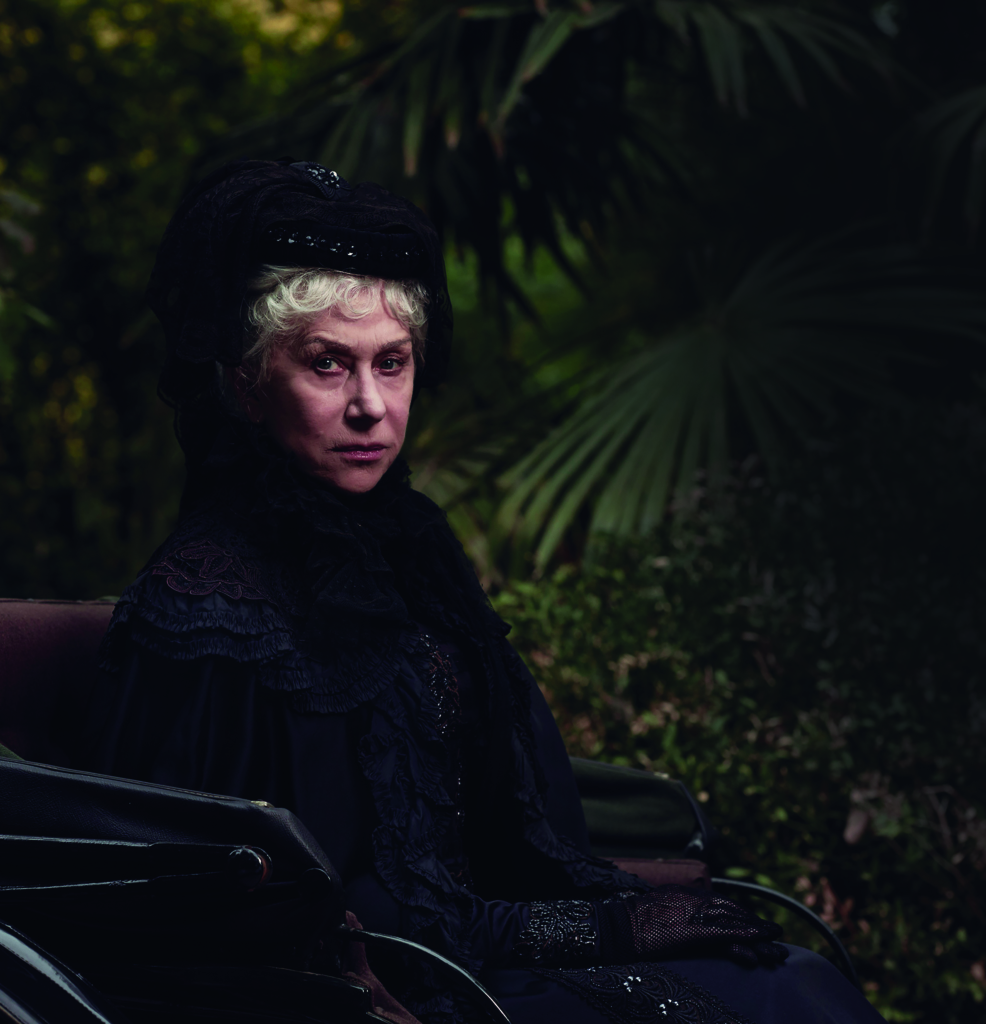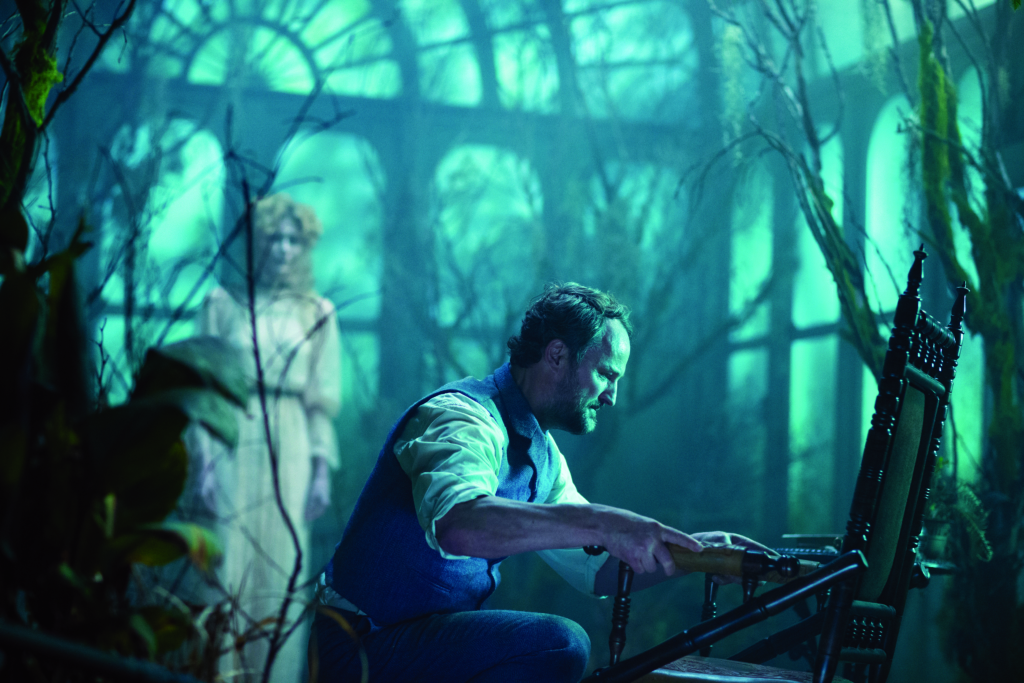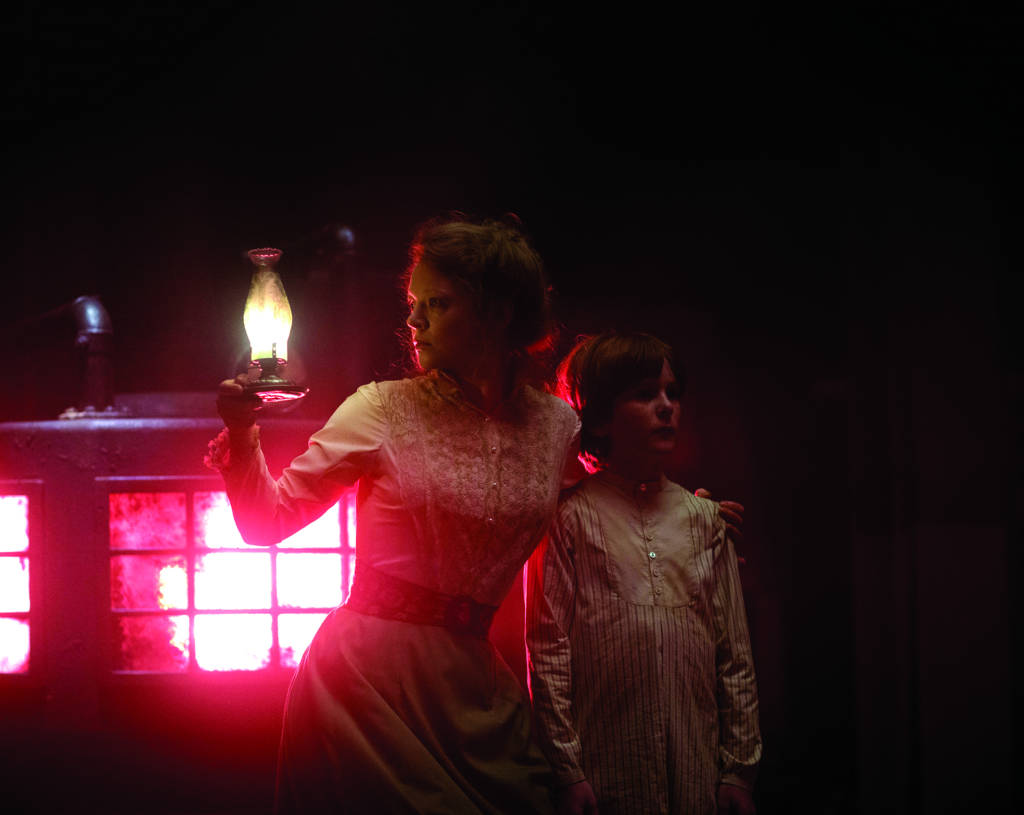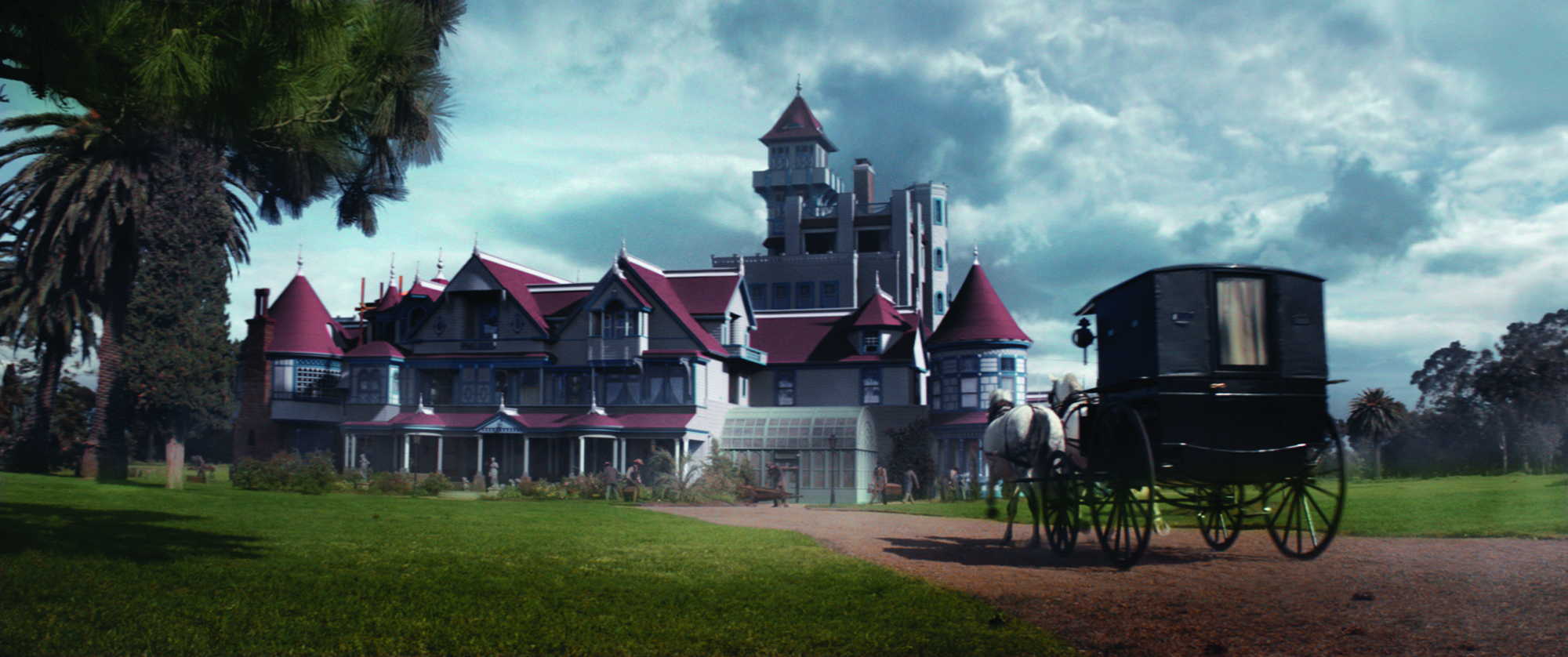How can you tell a true story about ghosts when no-one knows for sure whether ghosts are real?
Winchester (The Spierig Brothers, 2018) is a film based on the true story of Sarah Winchester, the eccentric millionaire who spent a large part of both her life and her fortune constructing what is supposedly one of the most haunted properties in the world. According to legend, in addition to inheriting her fortune and a 50 per cent shareholding in the Winchester Repeating Arms Company, Sarah believed that she was also heir to the ghosts of anyone ever killed by a Winchester gun. Building the California house and endlessly renovating it until it became a sprawling maze, then, was said to be her way of offering amends – giving the lost souls somewhere to settle.[1]StudioCanal, Winchester press kit, 2018, p. 7.
It’s hard now, over 100 years later, to separate fact from fiction. The truth is, no-one knows what Winchester’s true motivation was. Did supernatural belief guide her hand, or was she simply a wealthy woman interested in architecture? All that remains is the property she built – a sprawling mansion filled with strange details. Construction on the house took place continuously over almost four decades: rooms were demolished and rebuilt, wings shut off, and the turnover of staff and lack of a grand plan meant that the result was a seven-storey labyrinth filled with bizarre features. There are staircases that lead to nowhere and a door that opens onto a two-storey drop, and the number thirteen features heavily in the house’s design.[2]ibid.; see also Jordan Crucchiola, ‘Here’s What You Need to Know About the Spooky, Real-life Winchester House’, Vulture, 2 February 2018, <http://www.vulture.com/2018/02/heres-what-you-need-to-know-about-the-real-winchester-house.html>, accessed 25 May 2018.
Winchester is a horror film that leans into the legend. Brothers Michael and Peter Spierig – who also helmed 2014’s Predestination and 2017’s Jigsaw – alongside Tom Vaughan have crafted a screenplay that aims to fill in the gaps between the scant facts that are available. In their version, ghosts are real and the rumours are true. Set in 1906, the film follows the fictitious[3]Jeffrey M Anderson, ‘Winchester Could Have Been a Great “True” Ghost Story’, San Francisco Examiner, 2 February 2018, <http://www.sfexaminer.com/winchester-great-true-ghost-story/>, accessed 25 May 2018. Dr Eric Price (Jason Clarke) as he ventures into the mansion on the orders of the Winchester Repeating Arms Company, which is concerned about Sarah’s (Helen Mirren) vast expenditure and the control she has over the business. Price is offered generous compensation if he decides to rule her mentally unfit to continue holding the sway she currently has over the company. Addicted to laudanum and heavily in debt, the doctor is initially on board with the plan, but doesn’t believe in ghosts; however, the longer he spends in the house, the more his scepticism wavers.
In terms of its adherence to the horror genre, Winchester is a classic ghost story that is, at times, a little heavy on the tropes: there are jump scares, possessed children and flickering lights aplenty. The plot is also by the numbers and ultimately predictable. But, beyond its beautiful sets and attention to detail, the film’s real saving grace is the way in which it navigates truth and fiction, lacing history around the supernatural. The question ‘How much of this is real?’ is enough to elevate an otherwise potentially forgettable movie.

Constructing the film required a vast amount of research and some tough decisions. Striking the right balance between fact and fantasy is difficult, even when you don’t have to make a judgement on whether ghosts exist or not. Asked about how he and his brother decided on which story to tell based on the limited and sometimes-contradictory information available, Peter Spierig explains that they gathered stories and historical context from as many sources as possible, then drew out what felt like the most natural narrative. ‘We read most of what is out there,’ he tells me.
We talked to historians, talked to the [current owners of the] house, read material, and so you take the certain aspects that were real – that her husband and child died, that she did inherit this fortune, that she had this money to build […] and you can kind of extract pieces of information.
Spierig recounts that one of the greatest challenges was getting an idea of what the woman at the heart of the film was really like. ‘Sarah Winchester was somebody who was incredibly private and, even after her death, her staff [and] people around her were very private and very respectful,’ he says. ‘They said very nice things about her, but they never really said too much.’ To underscore just how reclusive she was, he points to the fact that there are only two pictures of Winchester in existence – ‘and one of them was taken without her really knowing,’ he says with a laugh.
Given that she spent so much of her life on its construction, the house she built has, in a way, become something of a metaphor for Winchester herself: complex, eccentric, with much of its past lost to history. As depicted in the film, vast amounts of the property were destroyed or damaged during the 1906 San Francisco earthquake, and no pictures exist from the time Winchester lived there. In terms of furnishings, Spierig recounts that ‘nobody really knows for sure what might have been there’, so the team was forced to make informed guesses about her aesthetic tastes, following consultations with historians.
The film depicts its subject as a tragic figure but not a victim. Mirren’s Sarah is dressed in head-to-toe black, shown to still be in mourning for her husband and infant daughter even though several decades have passed. In both film and legend, she starts building the house after seeking advice from a medium. This doesn’t mean the screenwriters view her as gullible or maddened by loss, however; they imbue Sarah with a steeliness – she has harnessed her sadness and turned it into a motivational force. Spierig recounts that, in researching the film, he and his brother, along with Mirren, agreed that all the evidence they had revealed Winchester to be ‘an intelligent woman who was grieving’. He is also quick to point out that, aside from building what is now known as the ‘Winchester Mystery House’,[4]See Winchester Mystery House website, <https://www.winchestermysteryhouse.com>, accessed 25 May 2018. much of her behaviour was quite normal for the era.
‘She created these innovative concepts [like] having piping through the house, so you could communicate. She was one of the first people in that area to have a phone, one of the first people to have a shower … so she was really a pioneer, really a clever woman.’
PETER SPIERIG
There were seances that she performed, [but] seances back then were a very different kind of thing to what they are now. It wasn’t as fringe – it was a thing that people did. They believed they were able to communicate with their loved ones that way.
While researching, the Spierig Brothers and production designer Matthew Putland (who earlier worked with the pair on Predestination) also visited the house multiple times, with the bare bones of the mansion offering further insights that helped shape the way the characters were developed.
Spierig’s respect for Winchester’s accomplishments and intellect is readily detectible as he talks about some of the less-often-discussed features of the property. ‘She created these innovative concepts [like] having piping through the house, so you could communicate,’ he muses. ‘She was one of the first people in that area to have a phone, one of the first people to have a shower […] so she was really a pioneer, really a clever woman.’ He continues:
She had a tremendous amount of wealth, so she was able to do the things that she really wanted to do, which was to build. I think, ultimately, she loved architecture and loved playing around with it.
Despite her reclusiveness, it is undeniable that Winchester was a real person who did live in the infamous house. When it comes to the ghosts that supposedly surrounded her, though, there is understandably far less evidence to work with. The writers had the option of leaving the ghosts’ existence ambiguous, and they even give themselves a possible out – when Price’s laudanum addiction is introduced, he is shown to also experience hallucinations. Instead, the film establishes early on that ghosts are real and that everything Sarah believes about them haunting her is true. Explaining this decision, Spierig says:
We felt that, if we’re going down the road of [Sarah being] haunted by these spirits, the spirits actually have to create a presence that is a threat. If you talk to a number of people who have come through the house, tour guides […] not all, but most of them will tell you they’ve seen something or felt something or heard something.

In terms of staying true to the spirit of the story, Spierig says that choosing to have real ghost characters ‘just felt like that was the right road to go down’. But this also opened up avenues for the narrative, particularly paving the way for Winchester’s main complication: how to deal with a powerful, angry spirit that is reluctant to move on and is hellbent on punishing Sarah for her connection to the Winchester Repeating Arms Company.
While the film’s stance on gun violence is ultimately confusing – guns suddenly become a necessary evil at the eleventh hour – the history of the Winchester rifle and the impact it had on warfare does lend the film weighty context both aesthetically and thematically. ‘Part of the story is that these ghosts [have been] killed at the hand of the rifle, so that gave us an opportunity to explore the time period and who would have been killed by [these weapons],’ says Spierig. The original Winchester rifle, made in 1866, was known as the ‘Yellow Boy’[5]‘Historical Timeline 1860–1899’, Winchester Repeating Arms website, <http://www.winchesterguns.com/news/historical-timeline/historical-timeline-1855-1899.html>, accessed 25 May 2018. and has an extremely high body count attached to it. Its successor, the 1873 model, is hailed as the ‘Gun That Won the West’[6]ibid. – which, according to Spierig, is ‘kind of a “politically correct” way of saying it killed a lot of Native Americans. It did horrible things.’
On top of his directorial and writing duties, Spierig also composed the score for the film, and the supernatural elements allowed him to explore some unusual territory and techniques. ‘It was a lot of fun to do, to create weird atmospheres and all kinds of strange sounds,’ he reflects. Most striking, perhaps, is his use of a cello that he gradually destroyed, whose sounds were recorded at different stages of destruction. Though he jokes about the technique – ‘play[ing] something wrong and badly, I can definitely do that!’ – there’s something apt and poetic about playing a dying instrument in a film that revolves around the meeting point between life and death.
The story of both Winchester and the house she built are like a game of Chinese whispers. During her lifetime, the constant construction meant that the house never really had a set form. Now that she’s gone, the house is ‘paused’, and we’re left looking at a still frame of a proverbial film we no longer have access to. As a tourist attraction, the new owners naturally have a vested interest in maintaining the legend and the ghost stories. None of the original furniture remains, small modifications have been made over the years, and it’s hard to know what is and is not genuine.[7]See Mary Farah, ‘10 FAQ’s on the Winchester Mystery House!’, Along Comes Mary, 15 September 2014, <http://www.alongcomesmaryblog.com/10-faqs-on-the-winchester-mystery-house/>, accessed 25 May 2018. We can’t even be certain whether the rumours of ghosts originated from Winchester herself or from those who sought to promote the house as a curiosity. It’s interesting how the more times the story of the widow and her mansion is told, the further away we potentially get from the truth. With every retelling, the story-maker is given the opportunity to add a little more detail.

Despite its over-reliance on the mechanics of the horror genre, Winchester treats its subject matter with deference. Yet, even with the depth of research that went into its creation, it’s impossible to know how the film stacks up to what really happened. It’s this very characteristic that makes the film so compelling. The few facts we do have are pillars holding up a century-old mystery, and our collective curiosity means that this is a story that will be told again and again. In the end, the truth is almost irrelevant.
Endnotes
| 1 | StudioCanal, Winchester press kit, 2018, p. 7. |
|---|---|
| 2 | ibid.; see also Jordan Crucchiola, ‘Here’s What You Need to Know About the Spooky, Real-life Winchester House’, Vulture, 2 February 2018, <http://www.vulture.com/2018/02/heres-what-you-need-to-know-about-the-real-winchester-house.html>, accessed 25 May 2018. |
| 3 | Jeffrey M Anderson, ‘Winchester Could Have Been a Great “True” Ghost Story’, San Francisco Examiner, 2 February 2018, <http://www.sfexaminer.com/winchester-great-true-ghost-story/>, accessed 25 May 2018. |
| 4 | See Winchester Mystery House website, <https://www.winchestermysteryhouse.com>, accessed 25 May 2018. |
| 5 | ‘Historical Timeline 1860–1899’, Winchester Repeating Arms website, <http://www.winchesterguns.com/news/historical-timeline/historical-timeline-1855-1899.html>, accessed 25 May 2018. |
| 6 | ibid. |
| 7 | See Mary Farah, ‘10 FAQ’s on the Winchester Mystery House!’, Along Comes Mary, 15 September 2014, <http://www.alongcomesmaryblog.com/10-faqs-on-the-winchester-mystery-house/>, accessed 25 May 2018. |





